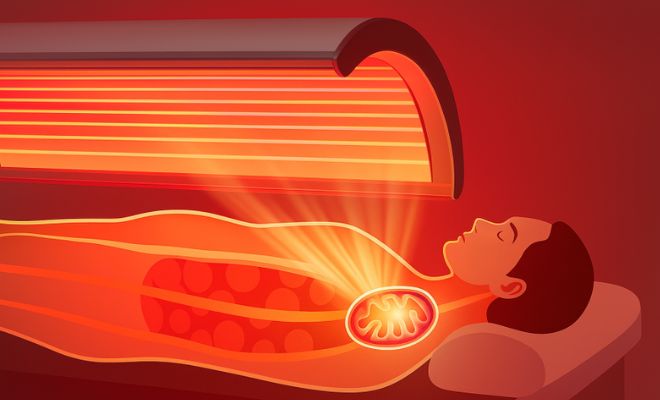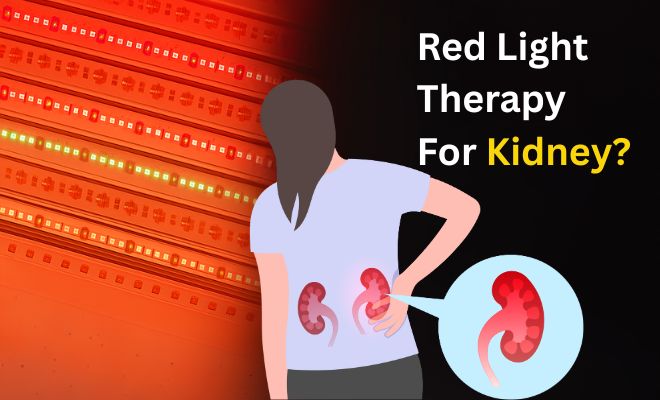Chronic kidney disease (CKD) is a silent epidemic, affecting more than 10% of the global population. Many people don’t realize they have it until significant kidney function is already lost. Traditional treatments, such as blood pressure control, blood sugar management, and dietary adjustments, aim to slow the disease’s progression but often fall short of reversing damage or significantly improving kidney repair. As a result, there’s growing interest in safe, non-invasive complementary therapies that support renal health.
Red light therapy (RLT), also known as photobiomodulation (PBM), is gaining attention for its potential to promote cellular healing, reduce inflammation, and enhance mitochondrial function. But could this light-based therapy become a supportive tool for people with kidney issues? Let’s explore the science, benefits, and practical applications of red light therapy for kidney health.
Key Takeaway:
Red light therapy isn’t a cure for kidney disease, but it may support healing, improve kidney function, and help protect against further damage, especially when combined with proper medical treatment. It’s a promising area of research worth watching as science continues to develop.
What Is Red Light Therapy?

Red light therapy is a treatment that uses specific wavelengths of light, mainly visible red light (620–700 nm) and near-infrared light (800–900 nm), to stimulate cellular activity. These wavelengths can safely penetrate the skin and deeper tissues without causing damage, unlike ultraviolet (UV) light. Instead of harming the skin, red and near-infrared light delivers energy directly to the mitochondria, the powerhouse of the cell, helping them produce more energy and support overall cellular function.
RLT has been widely used for:
- Wound healing
- Joint and muscle pain
- Skin rejuvenation
- Cognitive enhancement
- Inflammation reduction
Now, researchers are beginning to explore its effects on internal organs, including the liver, heart, and kidneys.
How Red Light Therapy Works (Mechanism of Action)
Red and near-infrared light affects the body at the cellular level by interacting with mitochondria, the “powerhouses” of cells. Here’s what happens during PBM:
- Boosts cellular energy (ATP): Light stimulates the mitochondrial enzyme cytochrome c oxidase, leading to increased ATP production, essential for cell repair and survival.
- Reduces oxidative stress: PBM helps balance reactive oxygen species (ROS), which can otherwise damage cells and tissues.
- Triggers anti-inflammatory responses: It downregulates pro-inflammatory markers like TNF-α and IL-6, which are often elevated in CKD.
- Improves blood flow: PBM supports vasodilation and microcirculation, improving oxygen and nutrient delivery where it’s needed most.
These effects could offer real value in protecting kidney function, particularly in individuals at risk of inflammation, oxidative damage, or mitochondrial dysfunction.
Potential Benefits of Red Light Therapy for Kidneys
1. Reduces Renal Inflammation
Chronic inflammation is both a cause and consequence of kidney disease. It promotes fibrosis (scar tissue formation), impairs blood filtration, and contributes to loss of function over time.
PBM has been shown in animal studies to reduce levels of pro-inflammatory cytokines and suppress immune overactivation. For example, rodent studies have demonstrated less inflammation in kidney tissue after RLT, suggesting it could slow damage in early-stage CKD.
By reducing inflammation, PBM could slow disease progression in early CKD and support healing in acute conditions like nephritis or sepsis-induced AKI.
2. Protects Against Oxidative Damage
Oxidative stress results from an imbalance between ROS and the body’s ability to neutralize them. The kidneys are especially vulnerable to oxidative damage due to their high metabolic activity.
RLT enhances endogenous antioxidant systems, including increased glutathione synthesis and superoxide dismutase (SOD) activity. This helps neutralize free radicals, protecting kidney cells from DNA, protein, and lipid damage.
Animal studies suggest that PBM can reduce lipid peroxidation and other markers of oxidative stress in kidney tissue. Lower oxidative stress also reduces the inflammatory cycle, offering dual protection against CKD progression.
3. Improves Mitochondrial Function in Kidney Cells
Kidney cells, especially those in the renal tubules, are highly energy-dependent. When mitochondria fail, the kidneys suffer.
In preclinical studies, RLT improved mitochondrial membrane potential and oxygen consumption rate in renal cells. This enhanced mitochondrial activity allows for faster recovery after injury, whether from toxins, ischemia, or diabetic damage.
Healthier mitochondria mean more efficient filtration, ion exchange, and overall renal function.
4. Supports Microcirculation in Renal Tissue
Healthy kidneys require a rich supply of oxygenated blood. Reduced microcirculation can cause hypoxia (low oxygen), tissue damage, and loss of nephrons.
PBM promotes angiogenesis (formation of new capillaries) and improves endothelial function. Better microcirculation translates to improved nutrient delivery, waste removal, and repair. This is particularly valuable for patients with diabetes, hypertension, or contrast-induced nephropathy, where kidney perfusion is often impaired.
5. Possible Regenerative Effects
Although more research is needed, early findings suggest PBM may:
- Stimulate stem cell migration to damaged areas
- Reduce apoptosis (programmed cell death)
- Encourage tissue remodeling and repair
These effects hint at the potential for kidney regeneration, not just protection.
Current Research and Evidence
Animal Studies
Most of what we know about red light therapy for kidneys comes from animal models:
- Rodents with AKI or toxin-induced kidney injury showed less tissue damage, improved kidney markers, and fewer signs of inflammation after RLT. (Source)
- Results are encouraging but still preliminary.
Human Studies
Human evidence is currently limited:
- A few case studies and pilot trials suggest potential benefits, especially in reducing systemic inflammation or improving fatigue in CKD patients.
- However, large-scale clinical trials are still needed to confirm safety, effectiveness, and optimal protocols for kidney-specific applications.
How Red Light Therapy Could Be Applied for Kidney Support
1. Targeting the Flank Area
To support kidney function with red light therapy, the light should be applied to the lower back area, just above the waist on both sides of the spine, this is where your kidneys are located. Using near-infrared (NIR) light in the 810–850 nm range is ideal because it can reach deeper tissues, potentially affecting the kidneys themselves.
Most people follow a routine of 10–20 minutes per session, about 3–5 times a week. High-powered LED panels or targeted NIR devices work best. For better results, it’s important to be consistent and make sure the light is aimed correctly at the kidney region.
2. Combining with Systemic PBM
Many patients with CKD experience chronic inflammation, fatigue, and mitochondrial dysfunction systemically.
Using full-body PBM beds or large light panels may support whole-body healing, not just kidney function. This approach is particularly useful for patients with multiple comorbidities (e.g., diabetes, cardiovascular disease) that affect kidney health indirectly.
3. Adjunct to Medical Treatment
PBM is not a substitute for dialysis, transplant, or medical therapy but it may complement them:
- Before or after dialysis to reduce inflammation
- Post-surgical recovery to promote healing
- During the early stages of CKD to preserve the remaining function
Always consult a healthcare provider before integrating PBM into a medical plan.
Safety and Considerations
Red light therapy is widely considered safe and non-invasive, especially when applied externally. Still, a few precautions are important:
- Avoid use over open wounds, active tumors, or during pregnancy unless cleared by a doctor
- Always consult a nephrologist or primary care doctor if you have a kidney condition and are considering PBM.
Support Your Kidney Health Huelight’s Whole Body Photobiomodulation Chamber

If you’re looking for a safe, science-backed way to enhance kidney health without drugs, invasive treatments, or guesswork, HueLight’s Whole Body Photobiomodulation (PBM) Device offers a breakthrough solution.
This full-body chamber uses over 40,000 medical-grade LEDs to deliver therapeutic red and near-infrared light deep into your tissues, helping to reduce inflammation, improve circulation, and support mitochondrial function all essential for protecting and revitalizing renal function.
Why Consider HueLight’s Whole Body PBM Chamber?
- Clinically proven wavelengths to target inflammation and oxidative stress at the cellular level
- 3D full-body irradiation for even, consistent exposure—ideal for systemic conditions like CKD
- Smart app control with customizable sessions—just 20 minutes to support your body’s healing pathways
- FDA-cleared, CE-certified, and GMP-approved, trusted by hospitals and clinics in over 20 countries
- Featured at PBM 2024 London as a leading innovation in non-invasive therapy
Whether you’re managing early-stage CKD, recovering from injury, or simply seeking proactive kidney support, our PBM system offers a powerful, non-invasive complement to your health routine.
Interested in learning more?
Reach out today to speak with a HueLight specialist. We’re happy to answer your questions and help you determine if the Whole Body PBM Chamber is the right fit for your wellness goals.
Contact Us to get started.













